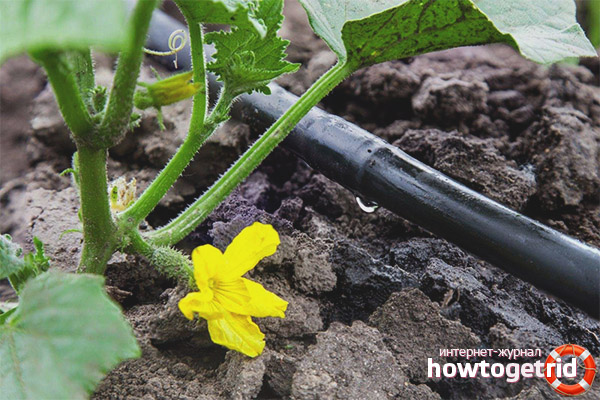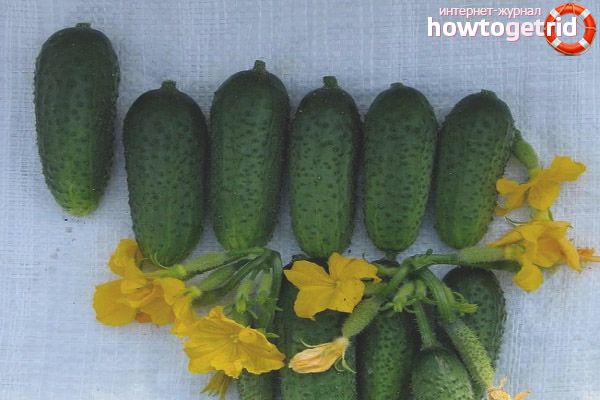The content of the article
Varieties of cucumbers are selected depending on what goals the gardener pursues when planting. Heroic strength is characterized by a high survival rate, unpretentiousness in care, which makes it ideal for the site.
Variety Properties
Cucumber f1 Heroic strength is a precocious partenocarpic type culture. Heroic strength is characterized by the flowering of the female type. Such cucumbers can be planted in greenhouses and on the open ground. Since the gherkin bundle hybrid is characterized by survival on new soil in a fairly short time, transplanting seedlings should be done at the end of frost - in April.
A distinctive feature of the f1 hybrid is its high yield. About 20 kg of fruit from one bush can be harvested. A long vegetation can also be called a characteristic feature, because the plant continues to bear fruit until the onset of autumn. Beam cucumbers require constant harvesting and regular processing.
Another determining factor of the variety should be noted the growth of the lashes, which is limited, due to which food is not taken away from the greens.
Bush features
The bushes of the Bogatyr Strength are characterized by an intensive growth of lateral shoots, for which the self-regulating branching of two species is inherent. All this allows us to ensure the duration of the period during which the bush bears fruit. During the active growth phase, a high degree of parthenocarpy can be observed. The number of nodes formed in the ovary can reach 8.
Characteristics of the Bush of Heroic Strength:
- Powerful main stem.
- Large leaves of a dark green hue.
- Thick lashes that wrap around the stem, gradually growing.
The required density of planting seedlings of the hybrid f1 in the greenhouse and the greenhouse is 1 square. m on the bush. In cases where planting is done on open ground, up to three plants per 1 sq. M are allowed. meter. When saving space and the formation of crowded seedlings, deformation of the lashes can occur, as well as damage to the root.
The root system, located in the upper layers of the soil, allows you to provide the stem with the amount of moisture that is needed. High growth rate of the bush is achieved due to properly performed, watering and the provision of the required care, and, in addition, regular harvesting.
Fruit Description
The variety is characterized by abundant flowering, which allows the formation of at least 6 fruits on a whip.
Fruits have the following features:
- shape - an oblong oval;
- permissible length - up to 14 cm, average diameter - 3 cm;
- dense core;
- juiciness;
- the average degree of pubescence of Zelentsy;
- insignificant number of seeds;
- thick peel;
- good transport tolerance, incl. - long.
In addition, the fruits are distinguished by good pickling qualities. Gherkins can be eaten raw, and also pickles are prepared from them for the winter. Cucumbers of this variety are able to maintain their presentation for 14 days.
Features of care and watering

Heroic strength is demanding on watering, for this variety it must be regular and timely. Bushes of the plant need constant cutting of excess lashes. The yield of the plant depends on how good the care is.
The fast formation of the stem is facilitated by top dressing, which allows to achieve the appearance of ovaries after 2 weeks after the completion of transplanting.When planting on open ground, it is necessary to cover the seedlings with a film, this will allow seedlings to grow faster and avoid damage from temperature extremes. When planting bunch cucumbers, you should choose a site in the shade, trying to avoid blown zones on the ground.
Cucumbers require regular recharge. Following the irrigation system, it is recommended to irrigate the soil and the main stem with a frequency of 2 times a week. It is necessary to stop irrigation during heavy rains. Watering the soil should alternate with its fertilizer. Fertilizers of nitrogenous origin and mineral complexes are used to strengthen the bush, mainly the green part. Carrying out such a procedure, one should adhere to the proportion: 15 g of fertilizer is required for 1 square meter. m of land. Fertilizing the soil can be done using home-made substances, for example, it can be manure and decayed foliage - they contribute to the activation of cell growth.
As soon as greens appear, it is necessary to proceed to the harvest every two days. Otherwise, there is a risk of overripening of the fruit, which, in turn, can impede the formation of new ovaries. Scourges should be trimmed only in cases of damage or disease of the bush.
Pests and possible diseases
Less commonly, a disease such as downy mildew may occur. Planted plants in unsuitable, non-fertilized soil are susceptible to threat. The lashes and the stalk are affected.
Ticks and aphids can be dangerous for the variety. Avoid this will allow special tools that strengthen the root system, as well as insecticides.
Parthenocarpic cucumbers will be an excellent choice for planting in the garden. Without needing special care, they stably carry a crop of large and tasty fruits. However, the variety needs timely watering and fertilizer. And in case of weakening of the plant, it becomes susceptible to certain diseases and prone to invasion of pests.
Video: how often and how much to water cucumbers?










Submit